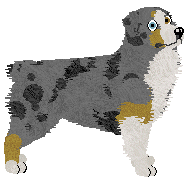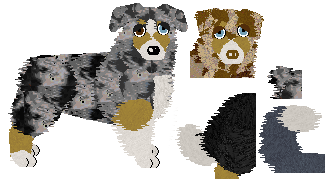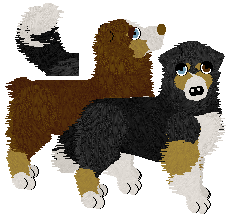


Merle: Red or blue merle (strict). Minimal Harlequin Merle is also accepted.
Tan: Any of the above colours with or without


 markings in the traditional or creeping (minimal) pattern.
markings in the traditional or creeping (minimal) pattern.Masking: A mask is allowed (standard mask). The mask is


 and matches the pigment of the rest of the dog (black in black dogs, liver in livers).
and matches the pigment of the rest of the dog (black in black dogs, liver in livers).White Markings: Any of the above markings may have
 as trim or in the irish spotting pattern. White on the face must not predominate and/or completely surround the eyes. Slight ticking on the muzzle and/or legs is allowed. White is not allowed to be present on the sides of the body, only as part of a collar or on the undersides. White on the collar, chest and forelegs may extend backwards for the width of the dogs eyeball beyond the withers, and white on the undersides may extend upwards to a line drawn from the point of the elbow to a point the height of an eyeball above the tuck, all without fault. White may also extend into the yellow area up to the red line as shown but is faulted to the degree to which the yellow area is infringed. White on the hindleg is subject to the usual Irish Spotting rules. The Red dog shown provides an example of what the maximum unfaulted white extension might look like on a dog.
as trim or in the irish spotting pattern. White on the face must not predominate and/or completely surround the eyes. Slight ticking on the muzzle and/or legs is allowed. White is not allowed to be present on the sides of the body, only as part of a collar or on the undersides. White on the collar, chest and forelegs may extend backwards for the width of the dogs eyeball beyond the withers, and white on the undersides may extend upwards to a line drawn from the point of the elbow to a point the height of an eyeball above the tuck, all without fault. White may also extend into the yellow area up to the red line as shown but is faulted to the degree to which the yellow area is infringed. White on the hindleg is subject to the usual Irish Spotting rules. The Red dog shown provides an example of what the maximum unfaulted white extension might look like on a dog.

 in blacks and blue merles,
in blacks and blue merles, 
 in livers and red merles. Blue and odd eyes are allowed without fault in all colours.
in livers and red merles. Blue and odd eyes are allowed without fault in all colours.
 in blues and blue merles,
in blues and blue merles,  in livers and red merles.
in livers and red merles. , but the less spots the better. More than 25 % is faulted, more than 50 % is DQed. Flesh on any non-merle is DQ.
, but the less spots the better. More than 25 % is faulted, more than 50 % is DQed. Flesh on any non-merle is DQ.









